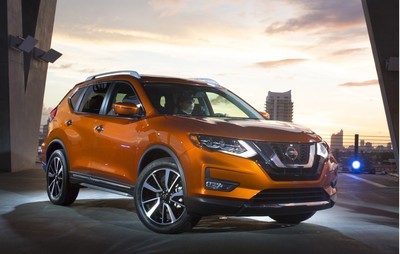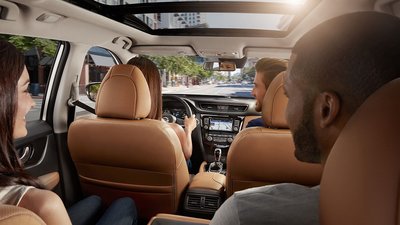HEELS ON WHEELS: 2017 NISSAN ROGUE REVIEW
HEELS ON WHEELS
By Katrina Ramser Parrish
San Francisco Bureau
The Auto Channel
INTRO TO THE ROGUE VEHICLE
Cargo and seating configurations keep the Nissan Rogue on your purchasing radar for your family’s next SUV – the price lulls you in as well, along with competitive fuel economy numbers at 27 miles-per-gallon combined with all-wheel drive.
I drove a 2017 Nissan Rogue with the standard 170-horsepower 2.5-liter four-cylinder engine paired to the Xtronic CVT automatic transmission with all-wheel drive. Available in four trims – the base S, SV. Midnight Edition and SL – my SL test drive came with the following standard features: six-way power driver’s seat with lumbar support; Quick Comfort heated front seats; leather upholstery; upgraded nine-speaker Bose audio system; seven-inch touchscreen navigation system; NissanConnect telematics system with navigation and mobile apps; Siri Eyes Free; Bluetooth; Divide-N-Hide cargo system; Around View monitor (rearview camera); push-button start; EZ Flex rear seating system; Divide-N-Hide cargo system; push-button start; LED headlights; power liftgate; roof rails; fog lights; safety technology (Blind Sport Warning, Rear Cross Traffic Alert); and eighteen-inch alloy wheel. Price as described came to $31,310 without options.
The Rogue underwent significant changes two model years ago, and while exterior styling has been refreshed, not much else has changed (I see some safety equipment is now standard on my highest-end SL test). Competition is very stiff and includes the Ford Escape, Toyota RAV4, Hyundai Tucson, Mazda CX-7 and the Honda CR-V.
HEELS ON WHEELS REVIEW CRITERIA
Stylish But Comfortable Results: The Rogue’s body now features sharper edges that better incorporate the headlights, so overall it does have a stronger design flow. Over the years, Nissan has worked out several ergonomic issues which includes streamlining the touchscreen, audio and climate controls, and replaced subpar materials with soft-touch upholstery and carbon-fiber detailing (material I feel are the same level as the Honda CR-V but not as nice as the Ford Escape’s). The EX Flex seats allow the second-row seats to have a 40/20/20 configuration with a sliding feature while the Divide-N-Hide sorts and hides away your objects into cargo floor. You can also opt for seating up to seven, although third row passengers will be cramped. Kids snap easily into belts and thankfully there is plenty of rear room. My test drive came with an optional $2,020 SL Premium Package that added a moonroof, LED braking, and Forward Emergency Braking; a $770 Platinum Package with larger nineteen-inch wheels and more safety tech (Lane Departure Prevention and Warning), and $250 Platinum Reserve Interior with unique leather seats and inserts.
Reliability & Safety Factor: As a Top Safety Pick, the Insurance Institute for Highway Safety (IIHS) gave the 2017 Nissan Rogue crash test scores of “Good” in every crash-test area. Note the headlights received an “Acceptable” even with optional equipment and ease of use with a child seat or LATCH earned just “Marginal.” The National Highway Traffic Safety Administration (NHTSA) gives the 2017 Rogue an overall rating of 4-Stars, siting side crash as doing the worst (you can see crash images on their website). Standard safety features for the Rogue include Vehicle Dynamic Control, Electronic Brake Force Distribution, anti-lock brakes, LATCH, energy-absorbing steering column, an advanced airbag system, Blind Spot Warning and Rear Cross Traffic Alert (more safety tech is optional).
Cost Issues: The base S trim starts at $24,420 with my loaded SL trim with options at $34,575. The 2017 Honda CR-V starts at $24,045 for the base LX and a recent fully loaded CR-V Touring trim test drive was $33,695. The Ford Escape prices are pretty much on the same level.
Activity & Performance Ability: The Rogue boasts aerodynamic panels around the rear pillars that help sweep the breeze away, supported by a low aerodynamic underbody for sound-reducing effects. While that’s a nice benefit, the 2.5-liter lacks excitement and continues to get the job of driving done is a flavorless manner. Also, engines are going smaller and the Rogue missed this trend: The Ford Escape now has a new 1.5-liter on the Escape that behaves with zest and command, while the Honda CR-V’s smaller 1.5-liter retained an amazing 28.8 miles-per-gallon with all-wheel drive during my test drive. Not to be outdone by the Hyundai Tucson’s 1.6-liter turbocharged four-cylinder engine with a seven-speed transmission.
The Green Concern: Fuel economy for the 2.5-liter four-cylinder with all-wheel drive claims 25-city and 32-highway for a combined 27 miles-per-gallon – I got maybe 26 even with Eco Mode on. The Honda CR-V with the 1.5-liter engine gets an EPA-estimated 27-city and 33-highway for a combined fuel economy of 29 miles-per-gallon with all-wheel drive (like I mentioned, I got about 28.8).
FINAL PARTING WORDS
The 2017 Nissan Rogue is an enticing SUV choice if your needs require many cargo and passenger configurations. Otherwise, performance won’t dazzle you on the road and at the pumps, at least not in the way several other competitors can.
©2017 Katrina Ramser Parrish
More Unbiased "Tell not Sell" Nissan Vehicle Research Information Anywhere!
- Nissan Buyers Guide | Specs, Prices, Expert Reviews and Comparisons 2018-1997
- Filter All Vehicles By Specs, Safety and Dimensions To Find Your Perfect Match
- 20+ Years of Nissan Reviews
- Nissan Archives; News, Reviews, Specifications, Prices, Video, Images (59,873 Annotations)
LEARN MORE: COMPARE 2017.5 Rogue Vs. 2017 Rogue Sport Side By Side




